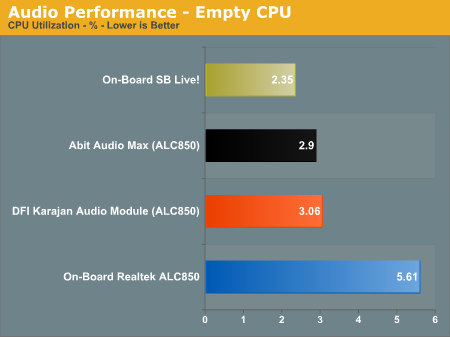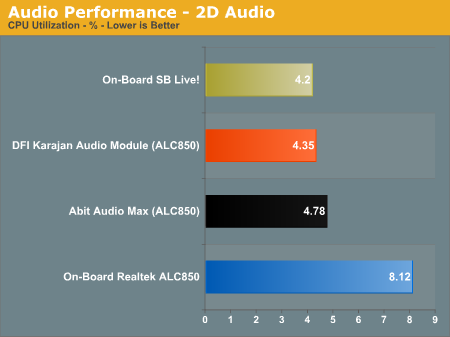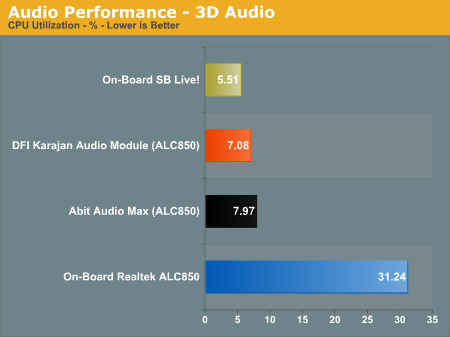nForce4 Ultra Roundup: Charting the Mainstream
by Wesley Fink on July 5, 2005 10:28 PM EST- Posted in
- Motherboards
Audio Performance
For this Ultra roundup, we limited audio testing to the Rightmark 3D Sound CPU utilization test, which is the same benchmarks that were run in the nForce4 SLI roundup. This benchmark measures the overhead or CPU utilization required by a codec or hardware audio chip.



DFI and Abit deserve praise for their excellent design work on the Karajan module and the Audio Max respectively. They both reduce overhead substantially to very low levels compared to competing implementations of the same Realtek ALC850 codec.










75 Comments
View All Comments
yacoub - Wednesday, July 6, 2005 - link
#33 - Wesley, that's awesome news. Can you post that somewhere more important so buyers know to be on the lookout for it? =)kyparrish - Wednesday, July 6, 2005 - link
Good article!I'm seriously considering dumping my DFI S754/NC 3200+ setup for that Epox board and a cheap S939 A64 :)
Wesley Fink - Wednesday, July 6, 2005 - link
#29 and #31 - UPDATE: I have talked with contacts in the Memory Industry and Samsung TCCD is now available again from Samsung. TCCD disappeared for a few months but production didn't really stop. TCC5 is DDR466 and TCCD is DDR500, but both chips come off the same line and are binned for speed grade. Samsung stopped binning for DDR500 grade until recently - and left this job to the memory makers.Recently Samsung has told memory makers they are binning once again for DDR500/TCCD and the TCCD chips are available again. It will take a few weeks for the pipelines to fill but TCCD is not dead. Some companies are staying with TCC5 at a lower cost and binning for the top performance unless the yields start to go down.
Wesley Fink - Wednesday, July 6, 2005 - link
#24 - The base nForce4 is sometimes called the nForce4 X4 and runs at 800 HTT, while the Ultra and SLI run at 1000HT. When 1000HT was first introduced we found no real difference in performance at 800HT and 1000HT. What the 1000HT did provide was quite a bit more overclocking headroom. A reader may have an example of where 1000HT outperforms 800HT but the real world difference is negligible.#28 - There are now more than 60 BIOS releases for the DFI nF4, many customized for particular memory types. Only 3 have been posted to their website. For the latest DFI nF4 BIOS a good place to check is www.xtremesystems.org or the BIOS Files Forum at www.bleedinedge.com. There is now a 7/04 BIOS that is reported to be more stable in upper memory ratios (433,466,500) with Rev. E chips.
#29 - You are overstating the TCCD situation. Corsair still sells TCCD, as do several other memory vendors. There is no doubt TCCD is drying up everywhere but Corsair, and that will continue. New TCC5 dimms that are said to perform like TCCD are in process in at least one memory company. We have requested these new TCC5-based dimms and will share our findings as soon as we receive the memory. There are also some new BH5 dimms that we thought were gone forever. We have even seen the new BH5 binned and advertised as DDR500 2-2-2 at higher voltages around 3.3V.
yacoub - Wednesday, July 6, 2005 - link
Well, while this review -has- convinced me to go with the DFI board over the Chaintech, that is purely due to the audio CPU usage issues of the onboard vs daughterboard. I'm shocked at how much difference that makes.That said, most of the memory testing (and thus most of the review) was meaningless to me (and everyone else who doesn't have access to TCCD memory anymore). =/
Wesley Fink - Wednesday, July 6, 2005 - link
#17 - Thanks for pointing out the errors. They have been corrected. Do you want a job proof reading :-)yacoub - Wednesday, July 6, 2005 - link
Regarding the tRAS recommendation:Can we petition Anandtech to stop using memory that the consumer can't get anymore? (Namely TCCD-based Plat Rev2.) Go pick up some TCC5 and do your tests with what the consumer is actually going to be receiving so your tests actually mean something.
mongoosesRawesome - Wednesday, July 6, 2005 - link
What BIOS version did you use with the DFI? It reads: "Award 7/01/2005 Release" in your list of features for the DFI, but I could not find that BIOS release on their website.AsiLuc - Wednesday, July 6, 2005 - link
Sorry I meant: GA-K8NF9http://www.giga-byte.com/MotherBoard/Products/Prod...
AsiLuc - Wednesday, July 6, 2005 - link
I'd liked to see the Gigabyte GA-K8NP9 reviewed, because it has passive southbridge cooling (silence :) ) and is cheap.